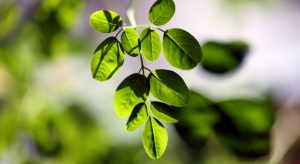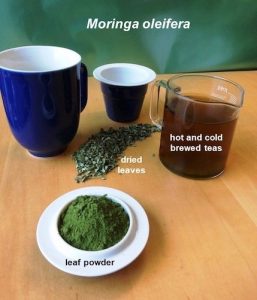A team of researchers from the Cullman Chemoprotection Center at Johns Hopkins University and the Universidad Nacional Autónoma de México led by Dr. Jed Fahey has developed a convenient and household-friendly method of extracting the beneficial compounds present in moringa, a tropical plant native to central and southern Asia. The findings were published on July 9 in “Plant Food, Nutrition, and Human Health,” a special issue of the journal Nutrients.
 Moringa, commonly known as horseradish tree or drumstick tree, is widely known for its nutritional and medicinal qualities. A growing body of scientific evidence suggests that moringin, a compound derived from moringa, may provide protection against chronic diseases, such as cancer and diabetes, and may be useful in treating the symptoms of mental disorders, such as schizophrenia or autism.
Moringa, commonly known as horseradish tree or drumstick tree, is widely known for its nutritional and medicinal qualities. A growing body of scientific evidence suggests that moringin, a compound derived from moringa, may provide protection against chronic diseases, such as cancer and diabetes, and may be useful in treating the symptoms of mental disorders, such as schizophrenia or autism.
Moringin is a type of phytochemical called an isothiocyanate. It is the byproduct of a reaction between two chemicals, glucomoringin and myrosinase, which are found in the leaves and stems of moringa.
Myrosinase, which is a type of enzyme, is also found in the human gut. It is produced by the commensal, or “friendly,” microbes that reside there. Myrosinase in the gut can convert ingested glucomoringin into moringin, albeit to varying degrees, due to variations in the gut microbial make-up among different individuals.
When people eat isothiocyanates like moringin, the compounds switch on the body’s in-house defense mechanisms to provide protection from disease. Identifying inexpensive, sustainable ways to deliver moringin to participants in research trials or as interventional treatment is important, especially in the developing world, where the burden of chronic, or non-communicable, diseases of both the body and mind is growing rapidly and treatment options are limited or non-existent.
Dr. Fahey and his colleagues set out to develop a product that could easily be mixed with other foods or used as a beverage that contained a calibrated amount of the phytochemicals under study. “The initial, immediate need was to develop something for use in clinical studies where we want to be able to deliver a precise amount of specific phytochemicals,” said Fahey. A second need was to develop a placebo for use in clinical trials with moringa, which has been challenging due to moringa’s distinctive bright green color and pungent flavor.
 The team of researchers developed two methods for extracting glucomoringin (the glucosinolate found in moringa) and moringin (the end-product isothiocyanate) from moringa and delivering them in a palatable beverage. A hot-water extraction method produced a palatable, yet astringent tea rich in glucomoringin, which must be converted to the active isothiocyanate moringin by the myrosinase in the gut. A cold-water extraction method, however, produced a milder, pleasant tasting tea, rich in the active isothiocyanate.
The team of researchers developed two methods for extracting glucomoringin (the glucosinolate found in moringa) and moringin (the end-product isothiocyanate) from moringa and delivering them in a palatable beverage. A hot-water extraction method produced a palatable, yet astringent tea rich in glucomoringin, which must be converted to the active isothiocyanate moringin by the myrosinase in the gut. A cold-water extraction method, however, produced a milder, pleasant tasting tea, rich in the active isothiocyanate.
“The cold teas delivered a known dose of isothiocyanate. For clinical studies this is actually better because we know exactly what we’re delivering to people,” said Fahey. “We think this will be a great delivery vehicle in clinical trials involving children who have autism.”
Identifying the efficiency of these phytochemical extraction methods for creating teas from moringa will facilitate the delivery of moringa tea to both adults and children in future clinical trials to gauge their effects on a wide range of health conditions, including autism, diabetes, and hypertension.
- Recent study identifies biomarkers for response to sulforaphane treatment in boys with autism - April 13, 2020
- Timing is Everything - March 6, 2020
- Profiles in Chemoprotection: Part II - September 5, 2019